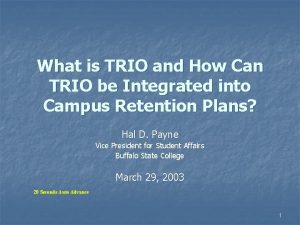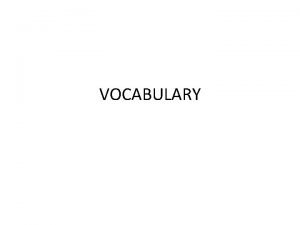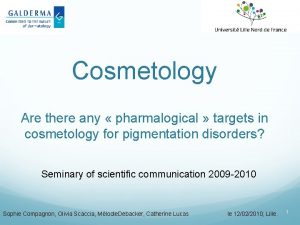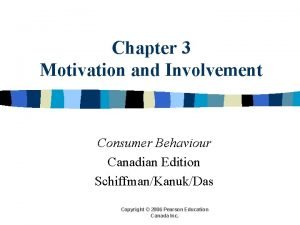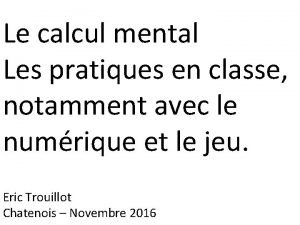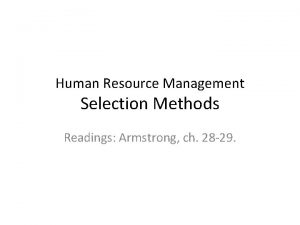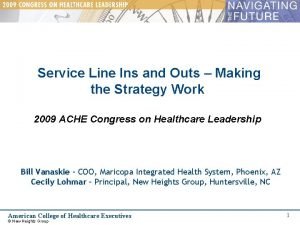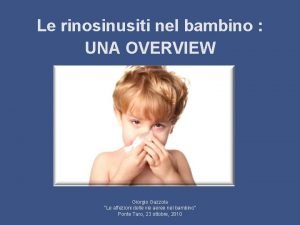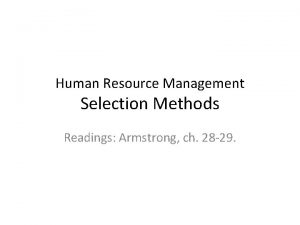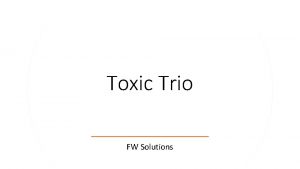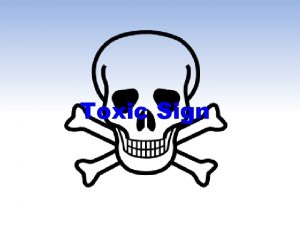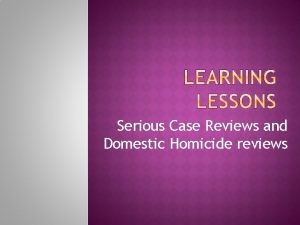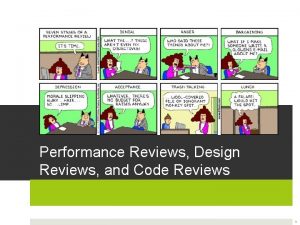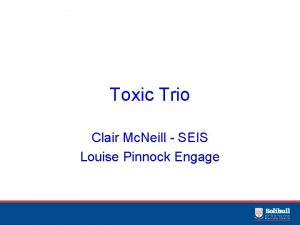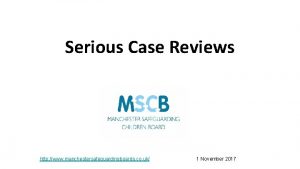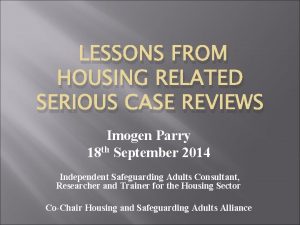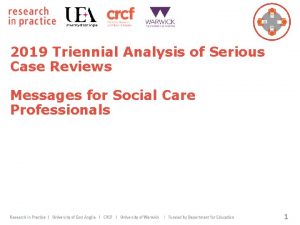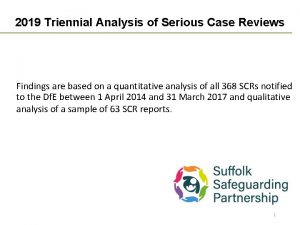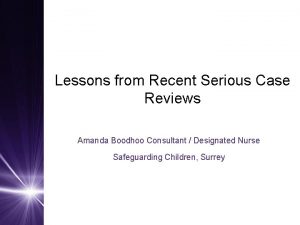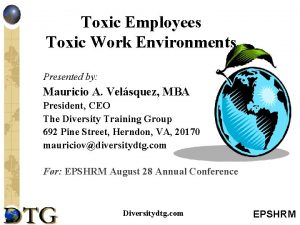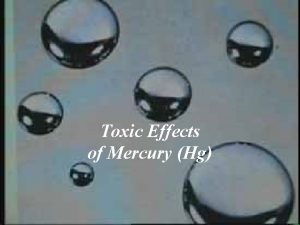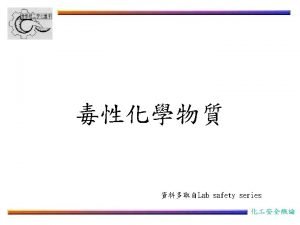Toxic Trio Serious Case Reviews and what we





















- Slides: 21

Toxic Trio: Serious Case Reviews and what we can learn from them David Mc. Clean Safeguarding Lead Mental Health Service

Outline • List of serious case reviews, published in 2015 and 2016 • Explanation of Toxic Trio and SCR’s • Broad breakdown of cases • Key issues/risk factors • Learning looked at

Toxic Trio • Environment in which a child lives is crucial to his or health, safety and well-being • 'Toxic Trio‘ - domestic abuse, mental ill-health and substance misuse • Identified as common features of families where harm to children has occurred • Viewed as indicators of increased risk of harm to children and young people • Large overlap between these parental risk factors and cases of child death, serious injury and poorer outcomes for children across all ages

Toxic Trio • Domestic abuse: any incident or pattern of incidents of controlling, coercive or threatening behaviour, violence or abuse • Substance misuse: causes serious negative consequences (physical, psychological, social and interpersonal, financial or legal) for users and those around them‘ • Parental mental illness: doesn’t necessarily have an adverse impact on child's developmental needs, but essential to always assess its implications for each child in family

Notifications and SCRs • Local Safeguarding Children Boards (LSCB) have responsibility for deciding whether or not to initiate a SCR in response to an incident and then notify Ofsted • Notifiable incidents are those involving death or serious harm to a child where abuse or neglect is known or suspected, and also deaths of children looked after and children in regulated settings

Numbers • 379 incidents notified to Ofsted between 2015 to 2016 • 385 incidents between 2014 to 2015 • LSCB notified Ofsted that they had decided to initiate a serious case review for 35% of cases 2015 -2016 (134) • 43% in 2014 -2015 (165)

Pattern of notifications to Ofsted suggests reduction in number and proportion of SCRs 164 200 150 134 76 90 100 74 60 50 0 2014 -15 Child Deaths 2015 -16 Serious Harm Total Notifications

Why are SCR’s commissioned? Children died, or were seriously harmed in a number of different ways: Physical injuries at the hands of the father or the mother’s partner Premeditated murder of the children following the breakdown of a relationship Death of the mother at the hands of her current or ex-partner MH DV Killed or seriously injured by a parent suffering from depressive mental illness or a severe psychotic episode Neglect as result of parents with mental health issues prioritising their own needs. Sudden infant death syndrome associated with co-sleeping Accidental ingestion of drugs Accidents (fire, drowning) due to inadequate adult supervision Parents deliberately giving children drugs SU

For the purposes of today: • • SCR’s sourced from NSPCC 64 published SCRs in 2015 25 SCRs in 2016 Only reviews featuring toxic trio looked at Domestic violence (DV) Mental illness (MH) Substance misuse (SU)

General observations • • All cases reviewed featured one of the trio 29 had Substance Misuse: 2 SU only 35 had Domestic Violence: 5 DV only 28 had Mental Illness: 5 MH only Substance Misuse and Domestic Violence: 11 Substance Misuse and Mental Illness: 5 Domestic Violence and Mental Illness: 7 All three: 11

Case numbers 2015 -16 Cases 35 28 29 7 DV MH SU 11 11 5 5 5 2 DV and MH and DV only MH SU only All MH SU SU only three

Breakdown of Cases • • • 11 cases: 8 deaths, 3 Non Accidental Injuries 8 deaths: 2 teenagers and 6 infants Teenagers: accidental OD (16 yo); murder (17 yo) Infants: 6 weeks to 22 months old Drowning, physical assault, co-sleeping • 3 NAI; 5 weeks to 14 weeks old • Fractures, assault, suspected sexual abuse

• What factors do you think are significant in SCR’s featuring toxic trio? • 5 minutes

Key factors relating to DV • History of violence • Young parents are a vulnerable group • Lack of take up of offered services • Different cultural norms • Trigger events can lead to a violent incident: 1. threats to kill 2. pregnancy 3. relationship breakdown and post separation contact • Substance misuse • Mental health problems

Key factors relating to MH • • • Disclosure of Suicidal feelings Threats to kill Stress factors Lack of engagement with services Substance Abuse Domestic Abuse

Key factors relating to SU • • • Assessments Rule of optimism Communicating with parents Interventions Mental Health Issues Domestic Abuse

• How might professionals and services learn from SCR’s featuring toxic trio? • 5 minutes

Learning for improved practice: DV • Understanding the roles of men in the family • Seeing the mother alone • Avoid over reliance on mothers ability to protect children • Seeing the bigger picture • Maintaining a healthy scepticism • Talking about DV between agencies • Understanding the complex nature of DV relationships • Understanding the impact on children of DV • Helping the mother understand the impact of living with DV

Learning for improved practice: MH • Understand the impact of parental mental illness on parenting capacity • Think family • Consider the pressures on other family members living with a parent with a MH problem • Listen to parents • Focus on the Child • Consider parental history • Have the Confidence to question and Challenge • Assessments

Learning for improved practice: SU • Assessment • Professional Awareness and Skills • Recommendations around working with the family • Reassessing risk as family circumstances change

Overall Learning Think family but focus on the child Timely appropriate assessments Parenting capacity Professional skills DV, MH and SU are all independent risk factors likely to cause safeguarding concerns • Presence of two or more significantly increases risk • • •
 Toxic trio definition
Toxic trio definition Victoria climbie case review
Victoria climbie case review Best worst and average case
Best worst and average case Eine kleine nachtmusik minuet and trio
Eine kleine nachtmusik minuet and trio Minuet and trio form diagram
Minuet and trio form diagram What is trio?
What is trio? Amo root word
Amo root word Indian burial ground candy bar
Indian burial ground candy bar Melanex trio
Melanex trio Dynamics of motivation in consumer behaviour
Dynamics of motivation in consumer behaviour Goodland trio
Goodland trio Electrabuzz
Electrabuzz Trio edwin morgan annotated
Trio edwin morgan annotated Valor de ac
Valor de ac Grille trio calcul mental
Grille trio calcul mental Classic trio' of selection techniques
Classic trio' of selection techniques Body trio nu skin cellulite
Body trio nu skin cellulite Service line strategy healthcare
Service line strategy healthcare Trio prp
Trio prp Infernal trio batteri
Infernal trio batteri Classic trio hrm
Classic trio hrm Elements and principles of design space
Elements and principles of design space





